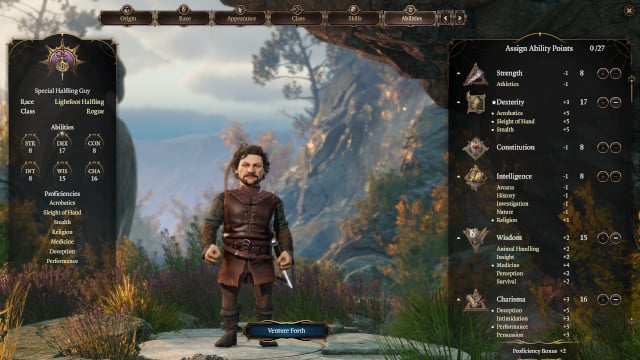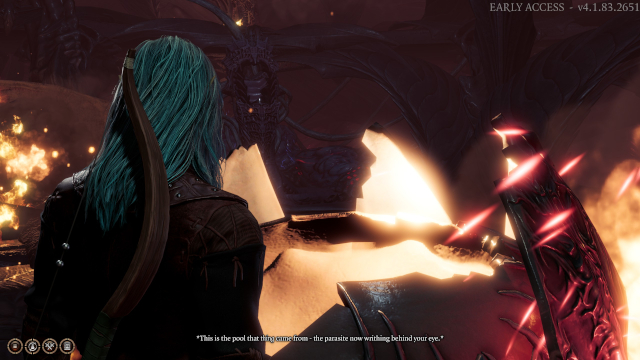So you’ve just started playing Baldur’s Gate 3, and you’re curious about the Rogue class. Assuming you don’t know much about the Dungeons & Dragons 5th Edition ruleset that BG3 is heavily based on, where do you even begin with your Rogue build? We’ve already dug into the motley of character customization options in D&D — er, Baldur’s Gate 3. Based on what we’ve seen so far, here’s the best strategy for Rogue builds in the initial character creation screen.
Baldur’s Gate 3 Best Rogue Build Guide
Character builds in Baldur’s Gate 3 boil down to a selection of:
- Race/Subrace
- Class/Subclass
- Origin + Background
- Skills
- Abilities (Stats, basically)
- Feats
Builds can also include other things like Cantrips and Spells, depending on which class you’ve chosen to play. There are several different approaches to building a great Rogue in Baldur’s Gate 3, however. You’re encouraged to build the character you’d like to roleplay, so if you follow this guide as a loose framework, you should find it much easier to create the Rogue of your dreams.
Baldur’s Gate 3 Rogue Starting Class Features
Some of the defining features of the Baldur’s Gate 3 Rogue include:
- Dexterity Saving Throw Proficiency
- Intelligence Saving Throw Proficiency
- Light Armour Proficiency
- Simple Weapon Proficiency
- Hand Crossbow Proficiency
- Longsword Proficiency
- Rapier Proficiency
- Shortsword Proficiency
The Rogue also starts with two special actions:
- Sneak Attack (Melee)
- Sneak Attack (Ranged)
Best Races for Rogues

There’s a heap of different races in Baldur’s Gate 3: 16 in total once subraces are accounted for. So, which race should you choose if you’re looking to create the best Rogue? To answer that question, we must note that races no longer grant unique racial stat bonuses. Therefore, each race you pick will give you Dexterity so we can simply focus on the unique racial abilities.
Wood Elf and Half-Wood Elf get a bonus called Mask of the Wild, which automatically grants proficiency to Stealth checks. This is especially useful for the Rogue, who gets an advantage from using their Sneak Attack actions. They also get Darkvision, which allows them to see 12 meters ahead in areas with no light.
Similarly, Lightfoot Halfling gets a bonus called Naturally Stealthy, which grants proficiency to Stealth checks. They also get Lucky, which forces a reroll whenever you land a dice roll of 1. This can be great in tight spots! However, Halflings lack the highly useful Darkvision power and only have a movement speed of 7.5m per turn. Duergar dwarves share the speed disadvantage but can grant you the Invisibility spell, which is useful for Rogues.
In contrast, Githyanki are an excellent option as they provide spells to increase your mobility. We want to place special focus on Enhanced Leap as it is vastly improved over its D&D 5e version. Speaking of bonus spells, if you are playing a ranged Rogue and need reliable Advantage on your attacks, the Drow’s Faerie Fire spell can provide that.
To sum up, the best races for Rogues ranked from stronger to viable are:
- Githyanki
- Wood Elf
- Lightfoot Halfling
- Drow/Half-Elf Drow
- Duergar Dwarf
The choice is essentially between getting Stealth proficiency from Elves and Halflings or getting useful utility and movement spells from Drows, Duergar, and Githyanki.
Baldur’s Gate 3 Rogue Primary Abilities
You can manually allocate your Rogue’s starting abilities out of the following:
- Strength
- Dexterity
- Constitution
- Intelligence
- Wisdom
- Charisma
Saving throws for Baldur’s Gate 3 Rogues are based on their Dexterity (DEX) and Intelligence (INT) ability, meaning that these are the two most important stats for you to allocate for your Rogue build.
Fortunately, you can rest easy as long as you focus on building up your Rogue’s Dexterity score first and foremost. This means you won’t accidentally “break” your Baldur’s Gate 3 Rogue build and render them useless in combat. That said, I want to point out that Dexterity only accounts for one general “flavor” of interaction outside of combat, and you should absolutely grant extra points to other abilities based on the type of character you’d like to roleplay.
Are you a cunning, smooth-talking type? Allot extra points into Charisma or boost your proficiency in Charisma-based skills to persuade or deceive other characters more easily. Or, are you a rugged swashbuckler with buttocks of steel? Bulk up your Constitution, which makes you take more damage before dying.
Best Rogue Skills

Baldur’s Gate 3 Rogues can manually choose four skills that they are proficient with, in addition to any proficiencies given by their chosen race and origin. I suggest starting your Baldur’s Gate 3 Rogue with proficiencies in:
- Acrobatics
- Sleight of Hand
- Stealth
All of these skills are Dexterity-based. However, you can also choose skill proficiencies that seem interesting to the character you’d like to roleplay as. Rogue can choose to become proficient in four skills from the following:
- Investigation (Intelligence)
- Athletics (Strength)
- Acrobatics (Dexterity)
- Sleight of Hand (Dexterity)
- Stealth (Dexterity)
- Insight (Wisdom)
- Deception (Charisma)
- Perception (Wisdom)
- Persuasion (Charisma)
- Intimidation (Charisma)
- Performance (Charisma)
Proficiency equates to an immediate +2 modifier for the skill in question.
Skills automatically receive a +1 modifier for every two points allocated to their corresponding ability, with 10 (+0) as the baseline. Skills also receive a -1 modifier for associated skills whenever a stat decreases to 9 or lower. For example, a Rogue who has 9 points in Strength also has an immediate -1 modifier to Athletics, whereas a Rogue who has 16 points in Dexterity also has an immediate +3 modifier to Stealth.
Note that all Elf characters begin with proficiency in Perception. Githyanki can choose up to five skills instead of four and become proficient in skills that are normally unavailable to Rogue.
Best Rogue Backgrounds

When choosing a background, you’re essentially choosing a basic starting point for your Baldur’s Gate 3 Rogue’s background story and two extra skill proficiencies. Off the bat, Urchin offers proficiencies in Sleight of Hand and Stealth, but Charlatan, Criminal, and Entertainer each carry at least one Dexterity-based proficiency, which can make them worth taking.
Don’t choose Urchin or Criminal if you play as Lightfoot Halfling, Wood Elf, or Half-Wood Elf, as you’ll be taking the same Stealth proficiency twice.
Likewise, High Elf (which gets its own Perception proficiency) shouldn’t take the Sailor origin, which offers the Perception proficiency as one of its two bonus proficiencies. Otherwise, just like in D&D, choosing your Baldur’s Gate 3 character’s origin is all about envisioning the character you want to roleplay as. Put those creative juices to work!
Baldur’s Gate 3 Rogue Subclasses

The Baldur’s Gate 3 Rogue has two unique subclasses. Once you reach Level 3, you can decide which subclass path you’d like your Rogue to follow. The subclasses, Thief and Arcane Trickster, both vary quite a lot in how they perform in combat. The Thief is granted an additional action each turn, whereas the Arcane Trickster is essentially a mage.
Thief
Choosing to play as the Thief subclass essentially makes your Rogue better at doing things any great Rogue should be able to do well: that is, being nimble and quick and dealing lots of damage. You gain the following features upon selecting the Thief subclass:
- Fast Hands: Gain an additional bonus action.
- Second-Story Work: Gain resistance to falling damage.
Arcane Trickster
Choosing to play as the Arcane Trickster subclass makes your Rogue into a pseudo-mage. This subclass is perfect for those who like to play as a Rogue that can also throw a few spells and illusions into the mix. You gain the following features upon selecting the Arcane Trickster subclass:
- Spell Slots Unlocked: Unlocks spell slots
- Mage Hand Legerdemain: When you cast Mage Hand, the spectral hand is invisible and can carry out additional tasks.
Additionally, you can select two of the following cantrips:
- Chill Touch
- True Strike
- Light
- Mage Hand
- Poison Spray
- Friends
- Shocking Grasp
- Acid Splash
- Blade Ward
- Dancing Lights
- Fire Bolt
Two of the following spells:
- Sleep
- Color Spray
- Disguise Self
- Charm Person
And one of the following spells:
- Fog Cloud
- Burning Hands
- Charm Person
- Magic Missile
- Longstrider
- Witch Bolt
- Jump
- Find Familiar
- Thunderwave
- Sleep
- Protection from Evil and Good
And that’s our guide on the best Rogue build in Baldur’s Gate 3 when starting a new game. If you found this guide helpful, please consider sharing it with other players, and stay tuned to GameSkinny for more builds and tips articles over the coming days.







Published: Aug 4, 2023 02:14 pm